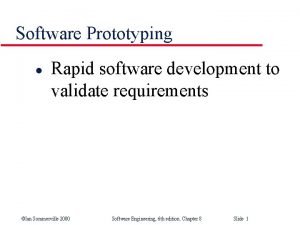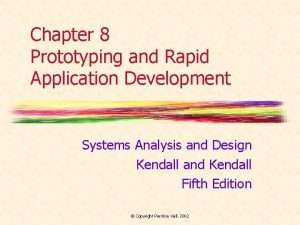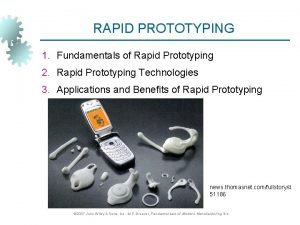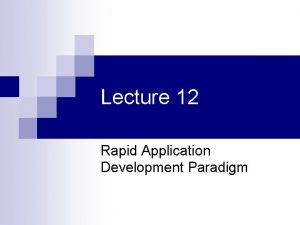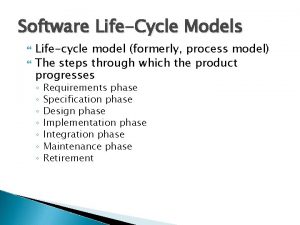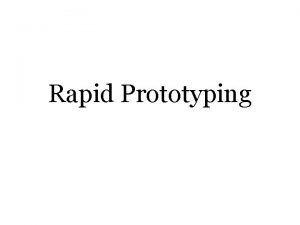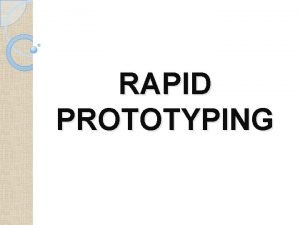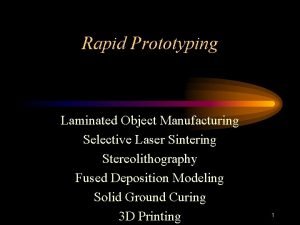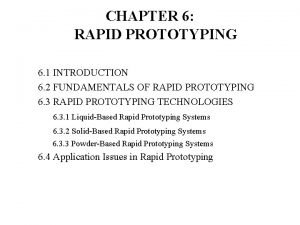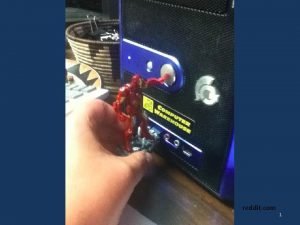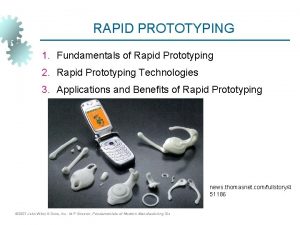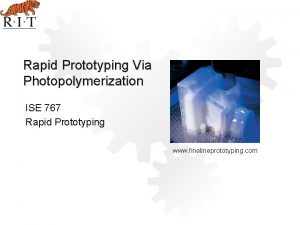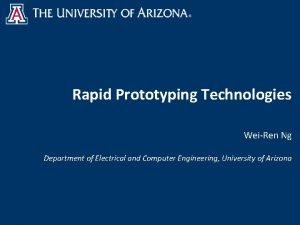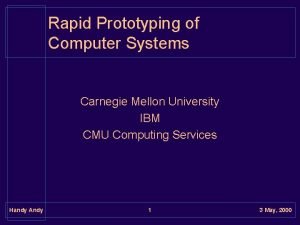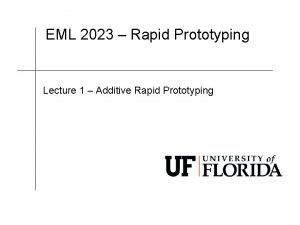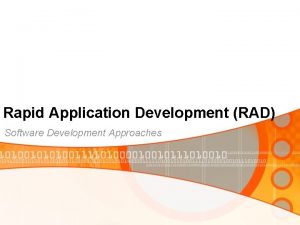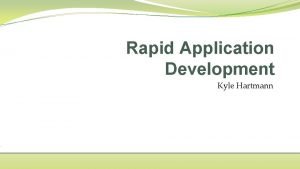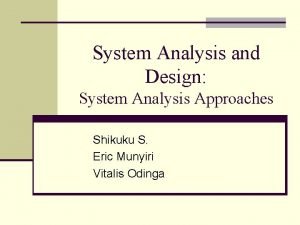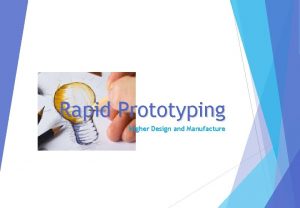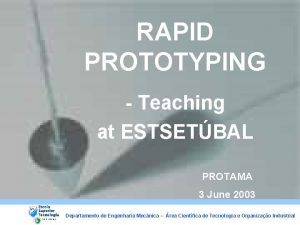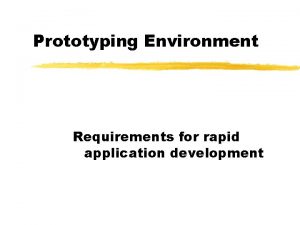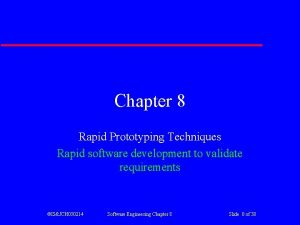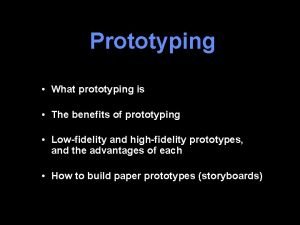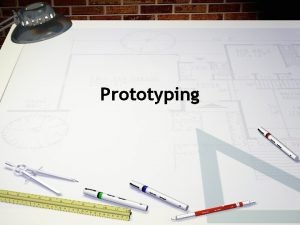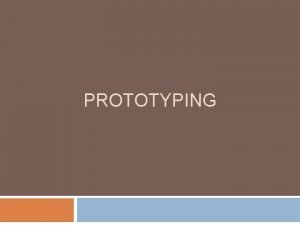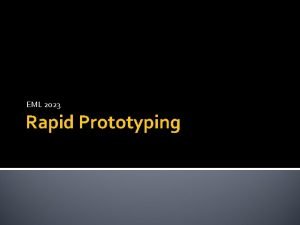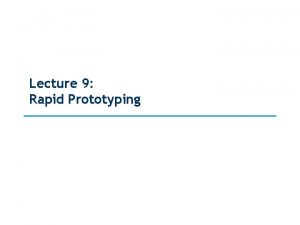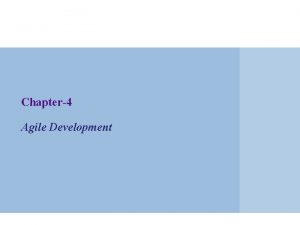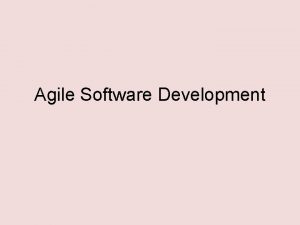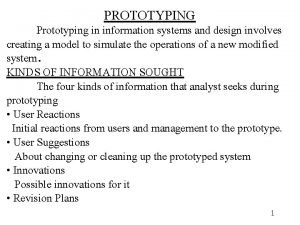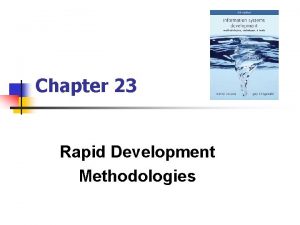Chapter 8 Prototyping and Rapid Application Development Systems

























- Slides: 25

Chapter 8 Prototyping and Rapid Application Development Systems Analysis and Design Kendall and Kendall Fifth Edition © Copyright Prentice Hall, 2002

Major Topics n n n Prototyping concepts Types of prototypes Prototyping and the systems development life cycle Prototype development guidelines Prototype evaluation Rapid application development (RAD) Kendall & Kendall Copyright © 2002 by Prentice Hall, Inc. 2

Prototyping n n n Prototyping is an information-gathering technique Prototypes are useful in seeking user reactions, suggestions, innovations, and revision plans Prototyping may be used as an alternative to the systems development life cycle Kendall & Kendall Copyright © 2002 by Prentice Hall, Inc. 3

Initial User Reactions n n Reactions must be gathered from users There are three types n n n User suggestions Innovations Revision plans Kendall & Kendall Copyright © 2002 by Prentice Hall, Inc. 4

Four Kinds of Prototypes n There are four conceptions of prototypes: n n Patched-up prototype Non-operational scale model First full-scale model Prototype which contain only some of the essential system features Kendall & Kendall Copyright © 2002 by Prentice Hall, Inc. 5

Patched-up Prototype n n n This is a working model with all the features but is inefficient Users can interact with the system Storage and retrieval of data may be inefficient Workable but inefficient May contain only basic features Kendall & Kendall Copyright © 2002 by Prentice Hall, Inc. 6

Nonoperational Scale Models n n A nonoperational scale mode is one which is not operational, except for certain features to be tested Prototype input and output Kendall & Kendall Copyright © 2002 by Prentice Hall, Inc. 7

First Full-Scale Models n n Create a pilot system An operation model Useful when many installations of the same information system are planned An example is a system to be installed in one location, tested and modified as necessary, and later implemented in other locations Kendall & Kendall Copyright © 2002 by Prentice Hall, Inc. 8

Selected Features Prototype n n n An operational model that includes some, but not all, of the final system features With the acceptance of these features, later essential features are added Some menu items are available System is built in modules These are part of the actual system Kendall & Kendall Copyright © 2002 by Prentice Hall, Inc. 9

Prototyping As an Alternative to the Systems Life Cycle n Two main problems with the SDLC n n n Extended time required to go through the development life cycle User requirements change over time Prototyping may be used as an alternative Kendall & Kendall Copyright © 2002 by Prentice Hall, Inc. 10

Prototype Development Guidelines n Guidelines for developing a prototype are n n Work in manageable modules Build the prototype rapidly Modify the prototype in successive iterations Stress the user interface Kendall & Kendall Copyright © 2002 by Prentice Hall, Inc. 11

Prototype Advantages n n n Potential for changing the system early in its development Opportunity to stop development on an unworkable system Possibility of developing a system that closely addresses users' needs and expectations Kendall & Kendall Copyright © 2002 by Prentice Hall, Inc. 12

Prototype Disadvantages n n n Managing the prototyping process is difficult because of its rapid, iterative nature Requires feedback on the prototype Incomplete prototypes may be regarded as complete systems Kendall & Kendall Copyright © 2002 by Prentice Hall, Inc. 13

Prototype Evaluation n n Systems analysts must work systematically to elicit and evaluate users' reactions to the prototype Three ways the user is involved n n Experimenting with the prototype Giving open reactions to the prototype n n Use a prototype evaluation form Suggesting additions to and/or deletions from the prototype Kendall & Kendall Copyright © 2002 by Prentice Hall, Inc. 14

Prototyping on the Web n Prototyping on the Web can help to facilitate the prototyping process by n n n Allowing users at a distance review the prototype and send comments Allowing users to review the prototype when they have time, and on any machine that has Internet capabilities The analyst does not have to install the software on the user’s computer Kendall & Kendall Copyright © 2002 by Prentice Hall, Inc. 15

Rapid Application Development (RAD) n RAD, or rapid application development, is an object-oriented approach to systems development that includes a method of development as well as software tools Kendall & Kendall Copyright © 2002 by Prentice Hall, Inc. 16

RAD Phases n There are three broad phases to RAD: n n n Requirements planning RAD design workshop Implementation Kendall & Kendall Copyright © 2002 by Prentice Hall, Inc. 17

Requirements Planning Phase n n Users and analysts meet to identify objectives of the application or system Oriented toward solving business problems Kendall & Kendall Copyright © 2002 by Prentice Hall, Inc. 18

RAD Design Workshop n n n Design and refine phase Use group decision support systems to help users agree on designs Programmers and analysts can build and show visual representations of the designs and workflow to users Users respond to actual working prototypes Analysts refine designed modules based on user responses Kendall & Kendall Copyright © 2002 by Prentice Hall, Inc. 19

Implementation Phase n n As the systems are built and refined, the new systems or partial systems are tested and introduced to the organization When creating new systems, there is no need to run old systems in parallel Kendall & Kendall Copyright © 2002 by Prentice Hall, Inc. 20

Martin Approach to RAD n The Martin approach to RAD includes four phases: n n Requirements planning User design Construction Cutover Kendall & Kendall Copyright © 2002 by Prentice Hall, Inc. 21

RAD and the SDLC n n n RAD tools are used to generate screens and exhibit the overall flow of the application Users approve the design and sign off on the visual model Implementation is less stressful since users helped to design the business aspects of the system Kendall & Kendall Copyright © 2002 by Prentice Hall, Inc. 22

When to Use RAD n RAD is used when n n The team includes programmers and analysts who are experienced with it There are pressing reasons for speeding up application development The project involves a novel ecommerce application and needs quick results Users are sophisticated and highly engaged with the goals of the company Kendall & Kendall Copyright © 2002 by Prentice Hall, Inc. 23

Using RAD Within the SDLC n n RAD is very powerful when used within the SDLC It can be used as a tool to update, improve, or innovate selected portions of the system Kendall & Kendall Copyright © 2002 by Prentice Hall, Inc. 24

Disadvantages of RAD n n May try and hurry the project too much Loosely documented May not address pressing business problems Potentially steep learning curve for programmers inexperienced with RAD tools Kendall & Kendall Copyright © 2002 by Prentice Hall, Inc. 25
 Rapid prototyping in software engineering
Rapid prototyping in software engineering Prototyping and rapid application development
Prototyping and rapid application development Solid based rapid prototyping factory
Solid based rapid prototyping factory Rapid application development disadvantages
Rapid application development disadvantages Advantages of stl file format
Advantages of stl file format Build and fix model has
Build and fix model has Define rapid prototyping
Define rapid prototyping Rapid manufacturing wikipedia
Rapid manufacturing wikipedia Rp technique
Rp technique Rapid prototyping could be an advantageous methodology
Rapid prototyping could be an advantageous methodology Rapid prototyping
Rapid prototyping Lom rapid prototyping
Lom rapid prototyping Powder based rapid prototyping
Powder based rapid prototyping Prototyping methodology
Prototyping methodology Copper polyamide rapid tooling
Copper polyamide rapid tooling Paper prototyping video
Paper prototyping video Powder based rapid prototyping
Powder based rapid prototyping Fineline rapid prototyping
Fineline rapid prototyping Rapid prototyping
Rapid prototyping Cmu rapid prototyping
Cmu rapid prototyping Eml 2023
Eml 2023 Bentuk awal contoh atau standar ukuran dari sebuah
Bentuk awal contoh atau standar ukuran dari sebuah Mexico rapid prototyping
Mexico rapid prototyping Rad in software engineering
Rad in software engineering History of rapid application development
History of rapid application development One shortcoming of rapid application development (rad) is
One shortcoming of rapid application development (rad) is
